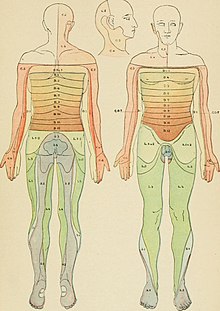Dermalgic reflex
The dermalgic reflexes according to H. Jarricot are a diagnostic method in osteopathy . They are based on the idea that visceral dysfunction is associated with skin changes in specific areas on the front of the trunk. For this purpose, Henri Jarricot created a topographic map in the 1970s.
background
From an osteopathic point of view, visceral osteopathy diagnoses and treats dysfunctions of internal organs, their connective tissue sheaths and supply lines. These are located in the thorax, abdomen and pelvis. Existing dysfunctions, however, are not limited to this conceptual subdivision in terms of their etiology and influence. Both the reliability and the effectiveness of visceral osteopathic diagnostics have so far not been achieved, also due to the poor quality of the study design. This generalization seems inadequate and ultimately cannot be applied to specific osteopathic techniques. Individual studies show good results for the Jarricot reflex zones, for example.
theory
Dermatomes and Headzones
Spinal nerves supply internal organs, skeletal muscles and certain areas of the skin. In the event of an infection with, for example, herpes zoster, including shingles, in which the herpes viruses infect the spinal ganglia and can cause very painful peripheral symptoms in the form of blistering on the skin, the pain is "... projected ..." onto the skin. This projection occurs only in the dermatome belonging to the spinal ganglion.
In “transmitted pain”, pain is transmitted from internal organs to the dermatome via the associated spinal cord segment. These areas are called head zones. This does not necessarily have to lead to spontaneous pain in the head zone, the areas are often tender or tense. Well-known and well-documented examples of this phenomenon are a possible pain in the left shoulder and arm during a heart attack or reflex reactions of the abdominal skin in acute appendicitis.This connection of the internal organs with the skin forms the theory behind the dermalgic reflex -Diagnostics according to Henri Jarricot.
Henri Jarricot's work on the dermalgia reflex
In “De certaines relations viscéro-cutanées métamériques en acupuncture”, Dr. H. Jarricot explicitly referred to the connection between organs and the skin and developed his theory of the dermalgia reflex. He emphasized that the respective reflex zones were only included in his map after multiple and diversified examinations and checks. This included, among other things, radiological and surgical methods. He did not provide comprehensible data.
Jarricot defined his dermalige reflex points using the following criteria:
"...
- A dermalgia reflex does not express itself spontaneously, but must be recognized by the examiner.
- The Palper-Roll [er] technique should be used to find the dermalgia reflexes. This method is intended to unroll large areas of skin. This makes it easier to distinguish between a pain-free and a painful [,] subjectively perceived area.
- There are defined shapes for each reflex zone.
- Each dermalgia reflex is found in a constant zone of a dermatome. This coincides with the development area of the perforating, vascular and neural system, which is [reflected] anterior, lateral and posterior. Paired organs are arranged symmetrically on the right and left, whereas unpaired organs are located homolaterally and possibly on the midline. This established somatopia is constant.
- The dermalgia reflex shows cutaneous somatizations of the nervous system, which can be traced back to certain organs. This allows the reflex not only to recognize the pain of the intestines, but also any reaction disorders.
- Disturbances of the large vegetative plexuses such as de [m] solar plexus, hypogastric plexus etc. each have a defined zone and can react to dermalgia reflexes.
- In organic dysfunction, a dermalgia reflex appears as long as this dysfunction persists. If this dysfunction is corrected, there is also no dermalgia reflex for the examined organ. The examination by means of the dermalgia reflexes proves to be particularly important for incidental functional disorders of the viscera.
- The dermalgia reflex serves as a diagnostic assessment method that is a differentiated and rapid method. ... "
execution
With a palpation technique, which is also called "... palper-rouler ...", the patient's skin is lifted with the thumb and forefinger and the resulting skin fold is gently rolled over the trunk without pinching. This movement is often compared to rolling a cigarette. The test is positive if the therapist reaches a reflex zone where the skin feels thicker and more puffy than the surrounding area. In addition, a positive result includes the patient's individually pronounced pain sensation in the tested skin area. Both conditions must come together for a positive test result.
Individual evidence
- ↑ T. Liem, TKDobler, M. Puylaert: Guide to Visceral Osteopathy . Ed .: M. Puylaert. 2nd Edition. Elsevier, Stuttgart 2009, ISBN 978-3-437-56012-5 .
- ↑ a b T. Liem, TKDobler, M. Puylaert: Guide to Visceral Osteopathy . Ed .: M. Puylaert. 2nd Edition. Elsevier, Stuttgart 2009, ISBN 978-3-437-56012-5 .
- ^ Basilie, F. et. al .: Diagnostic reliability of osteopathic tests: A systemativ review. Vol. 25. Journal of Osteopathic Medicine, September 2017, p. 21–29 , doi : 10.1016 / j.ijosm.2017.03.004 .
- ↑ a b c Oscar et. al .: Jarricot Dermatome Pain Test Validation as a Diagnostic Test of Organic Stress. In: Psychology Research . tape 4 , no. October 10 , 2014.
- ↑ a b Klinke et al .: Physiology . Ed .: Rainer Klinke, Hans-Christian Pape, Armin Kurtz, Stefan Silbernagel. 6th edition. Thieme, Stuttgart 2009, ISBN 978-3-13-796006-5 , p. 659 f .
- ↑ Roumen et al .: Acute Appendicitis, Somatosensory Disturbances ("Head Zones"), and the Differential Diagnosis of Anterior Cutaneous Nerve Entrapment Syndrome (ACNES). In: Journal of Gastrointestinal Surgery . tape 21 , 2017, doi : 10.1007 / s11605-017-3417-y .
- ↑ H. Jarricot: Des certaines relations viscéro, cutanees métamériques en acupuncture. In: Méridiens . tape 21 , 22 , 1973.
- ↑ Sarah Berstemann: The interrater reliability study of the Jarricot dermalgia reflex test. In: Master theses Osteopathieschule Germany . Hamburg 2019.

